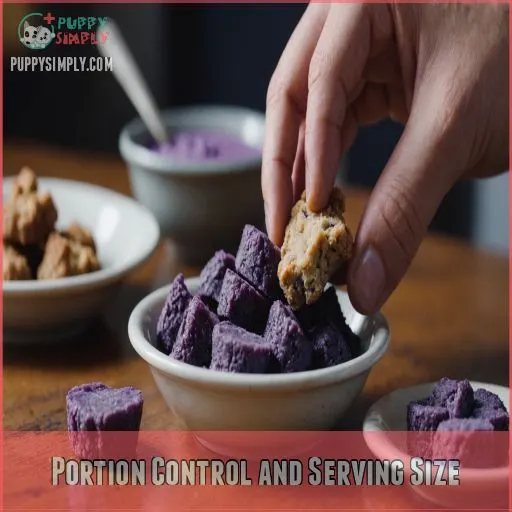This site is supported by our readers. We may earn a commission, at no cost to you, if you purchase through links.
 You might be wondering, "Can dogs eat ube?"
You might be wondering, "Can dogs eat ube?"
Good news, pup parents! Your furry friend can enjoy this purple powerhouse in moderation.
Ube, a Filipino yam, packs a nutritional punch with fiber, vitamins, and antioxidants.
But hold your horses – there are some ground rules.
Always cook ube thoroughly to reduce toxins, and start with small portions to avoid tummy troubles.
Skip the raw stuff and ube products with xylitol – they’re big no-nos.
Treat your pooch to plain ube bread or pancakes occasionally, and keep an eye out for allergic reactions.
Want to know how ube stacks up against other colorful veggies for your canine companion?
Table Of Contents
- Key Takeaways
- What is Ube?
- Nutritional Benefits for Dogs
- Risks of Feeding Ube to Dogs
- Preparation and Feeding Guidelines
- Safe Ube Treats and Alternatives
- Potential Health Benefits for Dogs
- Feeding Ube to Dogs in Moderation
- Frequently Asked Questions (FAQs)
- Are Ubes toxic to dogs?
- Can dogs eat Ube?
- Can dogs eat Ube pancakes?
- Can dogs eat raw Ube?
- Can dogs eat Japanese purple yams?
- Is raw ube poisonous?
- Can dogs eat purple taro?
- Can dogs eat Jamaican yam?
- How often can I give ube to my dog?
- Are there any dog breeds that shouldnt eat ube?
- Can ube help with my dogs skin issues?
- Is ube extract safe for dogs in small amounts?
- Can puppies eat ube, or is it for adult dogs only?
- Conclusion
Key Takeaways
- You can feed your dog cooked ube in moderation, but never raw as it contains toxins harmful to dogs.
- Ube offers potential health benefits for dogs, including antioxidants, fiber, and vitamins, but always introduce it slowly to monitor for allergic reactions.
- Avoid ube products with xylitol or other additives, and stick to plain, thoroughly cooked ube as an occasional treat.
- Limit ube to no more than 10% of your dog’s daily calorie intake, and consider safer alternatives like pumpkin or sweet potato for variety in their diet.
What is Ube?
You’ve probably seen ube pop up in trendy desserts, but did you know it’s actually a purple yam?
This vibrant root veggie is sweeter and earthier than regular sweet potatoes, and it’s packed with nutrients that might benefit your furry friend.
Origin and Nutrition Facts
Imagine this: a vibrant purple yam that’s taken the dessert world by storm. That’s ube for you!
Hailing from Southeast Asia, this Filipino staple has a sweet, nutty flavor with hints of vanilla. It’s packed with nutrients, offering a healthy dose of carbs, fiber, and vitamin C.
Don’t confuse it with taro, though! Ube‘s often the star in sweet treats like ice cream, lending its unique taste and eye-catching color to countless desserts.
Comparison to Sweet Potatoes
You might be wondering how ube stacks up against sweet potatoes for your furry friend.
While both are packed with nutrients, ube has a unique taste and texture.
It’s moister and has hints of vanilla and pistachio.
Ube takes longer to grow, making it less common in stores.
When cooking for your pup, remember that ube’s softer texture might be easier to mash into tasty dog treats.
Nutritional Benefits for Dogs
You might be surprised to learn that ube can offer some great health perks for your furry friend.
When cooked and served properly, this purple yam provides dogs with fiber for better digestion, vitamins to boost their immune system, and antioxidants to protect their cells.
Fiber and Digestion
For your pup’s digestive health, ube packs a fiber-filled punch.
This purple powerhouse can help regulate your dog’s bowels, potentially easing constipation or diarrhea.
The fiber in ube slows digestion, allowing for better nutrient absorption and promoting a feeling of fullness.
Just remember, moderation is key – too much fiber might lead to gas or upset tummies.
Think of ube as a tasty tune-up for your furry friend’s digestive engine!
Immune System Boost
Ube’s not just a pretty face in your pup’s bowl.
This purple powerhouse packs a punch for your dog’s immune system.
Loaded with vitamin C, ube helps your furry friend fight off pesky bugs and stay healthy (Source).
Much like omega-3 fatty acids, which reduce inflammation and support brain development, ube’s nutrient profile supports overall health.
It’s like giving your dog’s immune system a superhero cape!
Remember, moderation is key – too much of a good thing can lead to tummy troubles.
So, sprinkle some ube magic into your pup’s diet and watch their tail wag with joy!
Antioxidant Properties
Ube packs a powerful punch in terms of antioxidants.
These purple powerhouses are loaded with anthocyanins, the same compounds that give blueberries their superhero status.
While boosting your pup’s immune system, ube’s antioxidants also fight inflammation, potentially easing arthritis symptoms.
Think of ube as nature’s little helper, working overtime to keep your furry friend feeling young and spry.
Just remember, cooked ube is the way to go for maximum benefits and safety.
Essential Vitamins and Minerals
Beyond its antioxidant superpowers, this purple powerhouse packs a nutritional punch for your pup.
Ube’s role in dog health shines through its vitamin and mineral content.
Your furry friend can benefit from:
- Vitamin C for a stronger immune system
- Potassium to support heart and muscle function
- Calcium for healthy bones and teeth
These nutrients work together to keep your dog’s tail wagging. Just remember, moderation is key when introducing new foods to your pup’s diet.
Risks of Feeding Ube to Dogs
While ube can be a tasty treat for your pup, it’s not without risks.
You’ll need to be careful about how you prepare and serve this purple yam to keep your furry friend safe and healthy.
Raw Ube and Saponin Toxicity
While ube offers nutritional benefits, it’s not all sunshine and rainbows for your furry friend.
Raw ube contains saponins, which can be toxic to dogs.
If you’re considering adding ube to a raw diet, you should research the Raw Dog Food Benefits to understand the potential risks and rewards.
Different ube varieties have varying saponin levels, so it’s best to err on the side of caution.
Always cook ube thoroughly to reduce saponin content and make it safer for your four-legged pal.
Ube Extract and Xylitol Dangers
Let’s talk about a hidden danger in some ube products. You might think ube extract is a fun way to add flavor, but watch out! Some ube extracts contain xylitol, which is toxic to dogs. Even small amounts can cause dangerous blood sugar drops and liver damage.
Here’s why you should be careful with ube extract:
- It could make your pup seriously ill
- Your furry friend might need emergency vet care
- You’d feel awful if your treat choice hurt your dog
- Safe alternatives exist for purple-loving pooches
Potential Allergic Reactions
Now, let’s talk about potential allergic reactions to ube.
Just like humans, dogs can develop allergies to new foods.
Keep an eye out for signs like itching, hives, or upset tummy after your pup tries ube.
Some breeds might be more prone to food sensitivities, so it’s best to introduce ube slowly.
If you notice any weird reactions, it’s time to play it safe and chat with your vet.
Preparation and Feeding Guidelines
You’ll want to prep ube safely before sharing it with your pup.
Let’s look at how to cook this purple treat and figure out the right amount to give your dog.
Cooking Methods for Safety
Cooking ube for your furry friend is a piece of cake!
To make sure your pup’s safety, follow these tried-and-true methods:
- Boiling: Simmer peeled ube chunks until fork-tender
- Steaming: Place ube in a steamer basket for a gentle cook
- Baking: Wrap whole ube in foil and bake until soft
Avoid raw ube, as it contains toxins harmful to dogs.
Once cooked, let it cool before mashing or chopping.
Your four-legged sous chef will be wagging their tail in no time!
Portion Control and Serving Size
You’ve cooked the ube safely, but how much should you feed your furry friend?
It’s all about balance. Just like you wouldn’t eat a whole cake in one sitting, your dog shouldn’t gobble up too much ube.
Let’s break down the perfect portions for your pup:
| Dog Size | Ube Serving | Treats Per Day |
|---|---|---|
| Small | 1 tsp | 1-2 |
| Medium | 1 tbsp | 2-3 |
| Large | 2 tbsp | 3-4 |
| XL | 3 tbsp | 4-5 |
Remember, ube’s a treat, not a meal replacement.
Stick to these guidelines to keep your dog’s tail wagging!
Introducing Ube to Your Dog’s Diet
Before diving into ube treats, start small. Offer your pup a tiny bite of plain, cooked ube. Watch for any allergic reactions over 24 hours. If all’s well, gradually increase the amount. Mix it into their regular food or try homemade ube dog treats.
- Start with a pea-sized portion
- Cook ube thoroughly to avoid toxicity
- Monitor for tummy troubles or itching
- Mix with familiar foods for easy acceptance
- Reward your dog’s adventurous spirit with praise
Safe Ube Treats and Alternatives
You can treat your pup to ube-based goodies, but be careful with ingredients.
Stick to plain ube bread or pancakes in small amounts.
Try other safe, colorful fruits and veggies like blueberries or pumpkin for variety.
Ube Bread and Pancakes for Dogs
Now that you know how to prepare ube safely, let’s talk about some tasty treats for your pup.
Ube bread and pancakes can be a fun way to mix up your dog’s snacks.
Just remember, moderation is key!
Here’s a quick guide to dog-friendly ube treats:
| Treat | Recipe Tip | Serving Size | Frequency |
|---|---|---|---|
| Ube Bread | Use whole wheat flour | 1 small slice | Once a week |
| Ube Pancakes | Skip the sugar | 1 mini pancake | Twice a month |
| Ube Cookies | Use pumpkin puree | 1 small cookie | Once a month |
| Frozen Ube Cubes | Mix with plain yogurt | 1-2 cubes | As occasional treat |
Remember, these are special treats, not daily fare!
Avoiding Toxic Ingredients
When whipping up ube treats for your furry friend, steer clear of toxic ingredients.
Stick to dog-safe recipes and watch out for hidden dangers.
Here’s a quick guide to keep your pup safe:
- Avoid xylitol, a sweetener toxic to dogs
- Skip ube extract with risky propylene glycol
- Pass on chocolate and cheese additions
- Choose raisin-free recipes for safety
Always check ingredient lists and consult your vet if you’re unsure.
Your dog’s wagging tail will thank you!
Other Colorful Fruits and Vegetables
You’ve got a rainbow of options for your pup beyond ube!
Pumpkin’s a superstar for digestion, while beets pack an antioxidant punch.
Blueberries are tiny but mighty brain boosters.
Sweet potatoes offer a vitamin A bonanza, and carrots are crunchy tooth-cleaners.
Mix it up to keep your dog’s tail wagging. Just remember, moderation’s key – too much of a good thing can lead to tummy troubles.
Potential Health Benefits for Dogs
You might be surprised to learn that ube can offer some health perks for your furry friend.
When fed in moderation, this purple yam can help reduce inflammation, boost energy levels, and support healthy skin and eyesight in dogs.
Reduced Inflammation
For pups with achy joints, ube might be just the ticket.
This purple powerhouse packs a punch with its anti-inflammatory properties, potentially easing arthritis pain and soothing inflamed bowels.
Think of ube as nature’s ibuprofen for your furry friend.
It’s like giving your dog a cozy, purple hug from the inside out.
Just remember, moderation is key – too much of a good thing can lead to tummy troubles.
Improved Energy Levels
Energy flows from the purple powerhouse of ube!
Your furry friend might just get a pep in their step with this energy-boosting treat.
Ube’s fast-digesting carbs can fuel your pup’s playtime adventures.
Think of it as nature’s battery pack for active dogs.
Just a small serving can help maintain your dog’s metabolism and endurance throughout the day.
Remember, moderation is key – too much of a good thing can lead to an unexpected doggy marathon!
Healthy Skin and Eyesight
Imagine your pup with a shiny coat and bright, sparkly eyes.
That’s the potential power of ube for your furry friend’s health.
This purple powerhouse might just be the secret to your dog’s radiant appearance.
Additionally, incorporating soothing treatments like oatmeal baths for dogs can help calm irritated skin, promoting overall skin health.
Here’s how ube could benefit your canine companion:
- Boosts skin hydration, potentially soothing dry, itchy skin
- Supports overall coat health, promoting a lustrous shine
- Packs antioxidants that may protect your dog’s vision
- Contains nutrients that could help maintain eye health
Remember, moderation is key when introducing new foods to your pup’s diet.
Feeding Ube to Dogs in Moderation
You’ll want to keep a close eye on your pup when introducing ube to their diet.
Stick to small amounts and don’t let ube make up more than 10% of their daily food intake to avoid tummy troubles.
Monitoring for Adverse Reactions
While ube offers potential benefits, keep a watchful eye on your pup after feeding.
Look for signs of allergy like itching or upset stomach.
Different breeds may react differently, so monitor closely for 24 hours.
Compare your dog’s reaction to sweet potatoes as a benchmark.
Check in every few hours, especially if it’s their first ube experience.
Remember, your furry friend’s health comes first, so stay alert!
Maximum Daily Intake Recommendations
Feeding your pup ube is like giving them a purple treat, but moderation is key.
For small dogs, a teaspoon-sized Ube serving size is plenty.
Large dogs can handle up to a tablespoon.
Keep Ube dosage to 10% of their daily calories.
Watch for any Ube allergy risk signs like itching or upset tummy.
Remember, even good things can be too much of a good thing!
Frequently Asked Questions (FAQs)
Are Ubes toxic to dogs?
Raw ube contains toxins harmful to dogs, so you’ll need to cook it before serving.
Even cooked, large amounts can cause digestive issues.
Stick to small, occasional portions of properly prepared ube for your pup’s safety.
Can dogs eat Ube?
Cooked ube packs a purple punch with 27 grams of carbs per 100 grams.
Ube, also known as purple yam, falls under the category of root vegetables, which are safe root vegetables for dogs when prepared properly. You can safely feed your pup this vibrant veggie in moderation.
It’s a sweet treat that’ll have their tail wagging, but remember to cook it first!
Can dogs eat Ube pancakes?
You’ll want to think twice before sharing those ube pancakes with your pup.
While plain, cooked ube is safe for dogs in moderation, pancakes often contain ingredients that aren’t dog-friendly.
Stick to plain, cooked ube as an occasional treat instead.
Can dogs eat raw Ube?
Ironically, feeding your pup raw ube might land you both in the doghouse.
It’s a no-go, containing toxins harmful to dogs.
Always cook this purple powerhouse before sharing.
Your furry friend’s health comes first, so play it safe!
Can dogs eat Japanese purple yams?
Japanese purple yams are safe for your furry friend when cooked properly.
They’re packed with antioxidants and have a lower glycemic index than regular sweet potatoes.
Just remember to remove the skin and serve in moderation to avoid tummy troubles.
Is raw ube poisonous?
Raw ube contains toxins, so it’s not safe to eat uncooked.
Always thoroughly cook this purple yam before consuming.
Boil, bake, or fry it to neutralize the toxins and reveal its sweet, nutty flavor (Source).
Can dogs eat purple taro?
Like a hidden dagger in a fluffy pillow, purple taro hides a dangerous secret.
You shouldn’t feed it to your dog.
It’s toxic, containing sharp calcium oxalate crystals that can cause severe pain and inflammation.
Stick to safer treats instead.
Can dogs eat Jamaican yam?
You can feed your dog cooked Jamaican yam, but be careful.
Remove the skin and serve it plain in small amounts.
It’s packed with nutrients, but moderation is key to avoid potential health issues.
How often can I give ube to my dog?
Feed your dog cooked ube in moderation, starting with small pieces to check for reactions.
Offer it as an occasional treat, not daily.
Keep portions small to avoid upset tummies.
Think of it as a purple, veggie dessert for your pup.
Are there any dog breeds that shouldnt eat ube?
Barking up the wrong tree? There’s no specific breed that can’t eat ube.
All dogs should avoid it due to potential toxicity.
Instead, offer safe treats like bananas or peanut butter (without xylitol) in moderation.
Can ube help with my dogs skin issues?
While ube’s antioxidants may benefit skin health, there’s no direct evidence it helps dogs’ skin issues.
It’s rich in nutrients like vitamin C and anthocyanins, but always consult your vet before adding new foods to your pup’s diet.
Is ube extract safe for dogs in small amounts?
You shouldn’t give your dog ube extract.
It’s not typically used in canine diets and could potentially cause digestive issues.
Stick to dog-safe treats instead.
When in doubt, always consult your vet for advice on pet nutrition.
Can puppies eat ube, or is it for adult dogs only?
Puppies can enjoy ube too!
Start with small, cooked portions to avoid tummy troubles.
It’s packed with nutrients for growing pups, but moderation is key.
Remember, their main diet should be puppy food for balanced nutrition (Source).
Conclusion
Picture your pup with a purple-stained snout, happily munching on ube!
While this vibrant veggie can be a tasty treat, remember: moderation is key.
Cooked ube offers nutritional perks, but always watch for allergies or tummy troubles.
Stick to plain, well-prepared ube and avoid products with harmful additives.
By following these guidelines, you can safely introduce this purple powerhouse to your furry friend’s diet.
So, can dogs eat ube? Yes, but serve it smartly and sparingly for a colorful twist on their usual treats!















